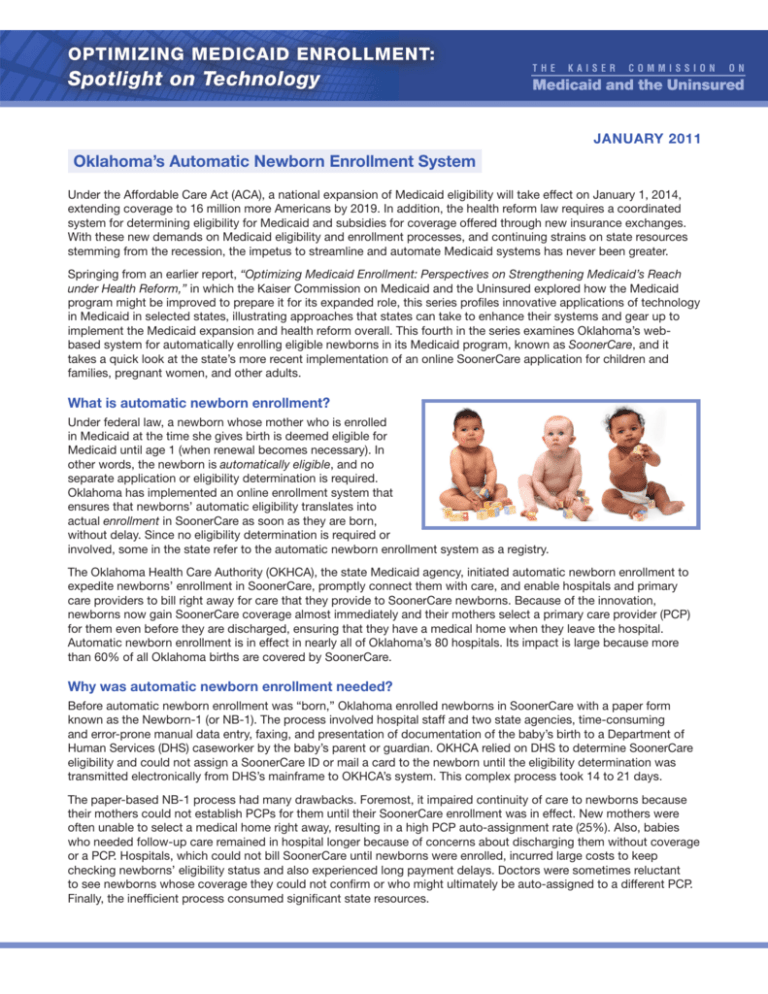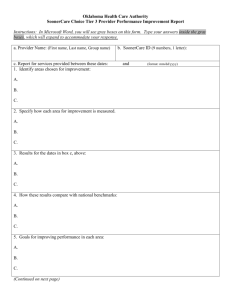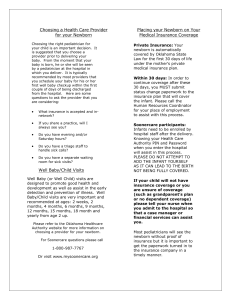Automatic Newborn Enrollment System
advertisement

January 2011 Oklahoma’s Automatic Newborn Enrollment System Under the Affordable Care Act (ACA), a national expansion of Medicaid eligibility will take effect on January 1, 2014, extending coverage to 16 million more Americans by 2019. In addition, the health reform law requires a coordinated system for determining eligibility for Medicaid and subsidies for coverage offered through new insurance exchanges. With these new demands on Medicaid eligibility and enrollment processes, and continuing strains on state resources stemming from the recession, the impetus to streamline and automate Medicaid systems has never been greater. Springing from an earlier report, “Optimizing Medicaid Enrollment: Perspectives on Strengthening Medicaid’s Reach under Health Reform,” in which the Kaiser Commission on Medicaid and the Uninsured explored how the Medicaid program might be improved to prepare it for its expanded role, this series profiles innovative applications of technology in Medicaid in selected states, illustrating approaches that states can take to enhance their systems and gear up to implement the Medicaid expansion and health reform overall. This fourth in the series examines Oklahoma’s webbased system for automatically enrolling eligible newborns in its Medicaid program, known as SoonerCare, and it takes a quick look at the state’s more recent implementation of an online SoonerCare application for children and families, pregnant women, and other adults. What is automatic newborn enrollment? Under federal law, a newborn whose mother who is enrolled in Medicaid at the time she gives birth is deemed eligible for Medicaid until age 1 (when renewal becomes necessary). In other words, the newborn is automatically eligible, and no separate application or eligibility determination is required. Oklahoma has implemented an online enrollment system that ensures that newborns’ automatic eligibility translates into actual enrollment in SoonerCare as soon as they are born, without delay. Since no eligibility determination is required or involved, some in the state refer to the automatic newborn enrollment system as a registry. The Oklahoma Health Care Authority (OKHCA), the state Medicaid agency, initiated automatic newborn enrollment to expedite newborns’ enrollment in SoonerCare, promptly connect them with care, and enable hospitals and primary care providers to bill right away for care that they provide to SoonerCare newborns. Because of the innovation, newborns now gain SoonerCare coverage almost immediately and their mothers select a primary care provider (PCP) for them even before they are discharged, ensuring that they have a medical home when they leave the hospital. Automatic newborn enrollment is in effect in nearly all of Oklahoma’s 80 hospitals. Its impact is large because more than 60% of all Oklahoma births are covered by SoonerCare. Why was automatic newborn enrollment needed? Before automatic newborn enrollment was “born,” Oklahoma enrolled newborns in SoonerCare with a paper form known as the Newborn-1 (or NB-1). The process involved hospital staff and two state agencies, time-consuming and error-prone manual data entry, faxing, and presentation of documentation of the baby’s birth to a Department of Human Services (DHS) caseworker by the baby’s parent or guardian. OKHCA relied on DHS to determine SoonerCare eligibility and could not assign a SoonerCare ID or mail a card to the newborn until the eligibility determination was transmitted electronically from DHS’s mainframe to OKHCA’s system. This complex process took 14 to 21 days. The paper-based NB-1 process had many drawbacks. Foremost, it impaired continuity of care to newborns because their mothers could not establish PCPs for them until their SoonerCare enrollment was in effect. New mothers were often unable to select a medical home right away, resulting in a high PCP auto-assignment rate (25%). Also, babies who needed follow-up care remained in hospital longer because of concerns about discharging them without coverage or a PCP. Hospitals, which could not bill SoonerCare until newborns were enrolled, incurred large costs to keep checking newborns’ eligibility status and also experienced long payment delays. Doctors were sometimes reluctant to see newborns whose coverage they could not confirm or who might ultimately be auto-assigned to a different PCP. Finally, the inefficient process consumed significant state resources. OPTIMIZING MEDICAID ENROLLMENT: Spotlight on Technology How does online enrollment of newborns work? When a baby is born in an Oklahoma hospital, a hospital enrollment coordinator searches the SoonerCare system to verify the mother’s SoonerCare eligibility. The enrollment coordinator calls the mother while she is still in the hospital and asks her to choose a PCP for her newborn from an online directory; PCP selection is a mandatory part of the automatic enrollment process. The directory displays all PCPs who are already connected with the family (e.g., older sibling’s PCP) and the mother can choose from them or select another PCP. The directory is searchable by PCP name, county, zip code, and distance from home, and it shows only PCPs whose panels are open. Once the baby has been named and a birth certificate has been completed, the baby’s data (i.e., name, sex, date of birth, etc.) are entered into the SoonerCare system’s “eNB-1.” (The citizenship field is pre-populated since the birth took place in the U.S.) The system immediately links the newborn’s case to the mother’s and generates a SoonerCare ID number for the baby; the linkage enables OKHCA to conduct outreach to the mother later on for wellbaby appointments and other follow-up. The system generates a temporary card for the newborn, and copies for both the hospital and the PCP so that they can bill SoonerCare for services right away. Providers can also check the SoonerCare website to verify that a baby is covered. A permanent SoonerCare card for the newborn is mailed home within a few days. This online enrollment process takes five minutes, compared to 60 minutes under the paper-based process, and the average time to add a newborn to the SoonerCare system is down to 3.5 days. What did it take? Oklahoma’s online enrollment initiative for newborns originally grew out of concerns articulated by the state’s child health leadership that babies were not getting the health care they needed soon enough. OKHCA’s growing interest in delinking SoonerCare eligibility determination altogether from the DHS process for other assistance programs was also a catalyst; the agency viewed simplification and delinking as integral to its effort to improve Oklahomans’ access to health coverage and care. Moving to a simple, independent SoonerCare enrollment process made sense especially given that nearly half of SoonerCare applicants are not seeking any other assistance. Once OKHCA decided to proceed, the agency worked with HP Enterprise Services (formerly EDS), its systems contractor, to map the old manual process, identifying bottlenecks and gaps. The team worked closely with hospital staff in the design phase, conducting focus groups with enrollment coordinators, getting feedback on “storefront” prototypes and refining the new online form and process, and then building systems “behind” them that fit with hospitals’ business processes. The state piloted eNB-1 in four hospitals in April 2008 to address any glitches before scaling it up. Existing funds were reprogrammed to finance implementation of automatic newborn enrollment; no additional funding was necessary. What impact has automatic enrollment of newborns had? By June 2010, Oklahoma had enrolled 50,000 newborns in SoonerCare automatically (nearly 2,000 babies are enrolled automatically every month). The process ensures not only prompt enrollment of newborns, but also consistent interpretation of eligibility rules previously implemented variably across counties and caseworkers. About 85% of newborns are automatically enrolled with the PCP their mother selects and the others are manually enrolled, with 99% ultimately getting the requested PCP. With their SoonerCare coverage and PCP in place before they leave the hospital, Oklahoma’s newborns start out with access to the care they need firmly established. In addition to its obvious benefits for newborns, automatic newborn enrollment has also yielded benefits for hospitals, PCPs, and the state. Savings to hospitals, in terms of billing staff and speedier payment from SoonerCare, have not been quantified but are viewed by Oklahoma’s hospitals as a substantial gain. The system improves support for provider participation in SoonerCare by enabling PCPs to verify a newborn’s coverage and medical home selection in real-time and be paid promptly. Increased administrative efficiency at the state level is an additional advantage of the system. Between April 2008 and June 2010, the use of eNB-1 freed up 22 state FTEs to conduct other activities. The automated system can also generate reports to support program management and monitoring purposes. The principal challenge associated with online newborn enrollment has been training. Because staff turnover is significant in many hospitals, retraining is an ongoing need. OKHCA monitors hospitals’ newborn enrollment trends closely to detect unexpected dips in the numbers or other unexplained changes that might indicate gaps in staff knowhow and needs for retraining. Notably, however, the system’s simplicity makes training easy. Oklahoma’s Automatic Newborn Enrollment System OPTIMIZING MEDICAID ENROLLMENT: Spotlight on Technology How is use of online systems in SoonerCare expanding? Building on the success of its online process for newborns, in September 2010, OKHCA launched a new “No Wrong Door” online application process for children and families, pregnant women, and adults seeking SoonerPlan family planning coverage. Over half of new SoonerCare applications now come in online. SoonerCare eligibility is simplified, people can apply at any time of day or night and from any computer, and applications are processed in real-time. SoonerCare “members” establish and can review and update their online accounts anytime, and their coverage is automatically extended for 12 months whenever they update their information. Application assistance is available through state agency and Tribal partners, as well as community-based organizations; individuals who prefer to use a paper application still have the option. OKHCA plans to expand online enrollment soon by adding its breast and cervical cancer treatment program, its premium assistance program, and WIC to the application. The state used a $6.3 million HHS Medicaid Transformation Grant to help finance the online enrollment initiative. Oklahoma’s use of technology in the health sphere is not limited to improving coverage. For example, in January 2011, OKHCA implemented a Medicaid Electronic Health Records Incentive Program, which uses federal funds as an incentive to providers serving a certain volume of SoonerCare patients to adopt, implement, or upgrade electronic health records technology. With this initiative, Oklahoma is capitalizing on technology’s power to further another of the state’s aims, to improve the coordination and quality of patient care. Looking toward 2014 The online processes that Oklahoma has designed and implemented so successfully for SoonerCare give the state a strong foundation on which to build a single, integrated online application and enrollment process for health coverage through Medicaid, CHIP, and the new health insurance exchanges, as required by ACA beginning in 2014. The enrollment gains achieved in Oklahoma through automatic newborn enrollment and the “No Wrong Door” system exemplify the potential that innovative uses of technology hold for achieving a central goal of health reform – expanding health coverage to millions of uninsured Americans. The following related reports are also available at www.kff.org: Optimizing Medicaid Enrollment: Perspectives on Strengthening Medicaid’s Reach Under Health Care Reform (#8068) Optimizing Medicaid Enrollment: Spotlight on Technology - Using Schools and Data Matching to Enroll Kids in Medicaid and CHIP (#8123) Optimizing Medicaid Enrollment: Spotlight on Technology - Wisconsin’s ACCESS Internet Portal (#8119) Optimizing Medicaid Enrollment: Spotlight on Technology - Louisiana’s Express Lane Eligibility (#8088) This publication (#8133) is available on the Kaiser Family Foundation’s website at www.kff.org. THE HENRY J. KAISER FAMILY FOUNDATION Headquarters: 2400 Sand Hill Road Menlo Park, CA 94025 www.kff.org 650.854.9400 Fax: 650.854.4800 Washington Offices and Barbara Jordan Conference Center: 1330 G Street, NW Washington, DC 20005 202.347.5270 Fax: 202.347.5274 The Kaiser Family Foundation is a non-profit private operating foundation, based in Menlo Park, California, dedicated to producing and communicating the best possible analysis and information on health issues.





